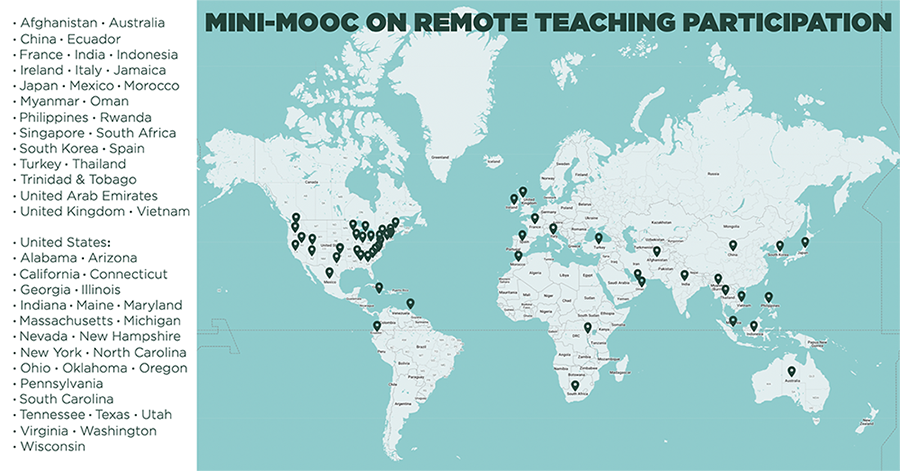In March of 2020, as COVID-19 called for rapid transitions in teaching and learning environments, many teachers felt overwhelmed by uncertainty and an abundance of options (often with very little guidance or structure). Team MAET identified this gap in professional development needs and designed a solution: The Mini-MOOC on Remote Teaching. MOOC is an acronym for Massive Open Online Course. To date, this free, asynchronous course has more than 1,813 participants from 26+ countries and 26+ U.S. states. The Mini-MOOC is still free and open to the public and Michigan educators can receive SCHECHs until June 30, 2021 for completing the course (directions are on the homepage of the course in D2L). With a year of implementation behind us, we wanted to take time to reflect on the design process.

The Need and Idea
Watching “teacher Twitter” and getting information from our MAET network, we recognized that there was an urgent need for high quality resources in spring 2020 to help educators transition their face-to-face teaching to remote, online, or hybrid learning environments.
The Collaboration and Design
So, in a manner of days (3, to be exact), we–Candace Robertson, Liz Owens Boltz, and Brittany Dillman–designed a course outline to address the learning objectives that emerged from the needs we saw from the MAET network. We then created key learning objectives (using solid backward design), created content, revised, and polished content to support these learning objectives, and built a learning community to surround it. We used a “baton passing” method in which one person would write a draft of a unit’s content, the next would revise and improve upon that draft, and the third would make a final pass to polish it.
The Implementation and Iteration
We recognized early on that it would be important to distill the many complex aspects of remote teaching into digestible, high-priority topics. One of the problems we identified with the available supports being provided to teachers was that they often included an overwhelming list of resources. We took an alternative approach, focusing instead on smaller chunks of content that could be explored (and implemented) in short amounts of time.
We heard from many participants that many of the approaches and strategies we used were effective. For example, throughout the course we provided design insights from the development team to explain some of the choices we made. These “pull back the curtain” moments provided context for the way content was crafted (e.g., avoiding ableist language), why we chose to include an overview of required technologies for the course, and how units were structured. Our intent was for participants to get a sense of the discussions and decision points that occurred “behind the scenes” during course development, since many of them were engaging in a similar process building the remote aspects of their learning experiences.
The majority of the feedback we received about the course was incredibly positive, but we did find that the name “MOOC” may have been a barrier for some educators who were not familiar with the phrase. Perhaps some version of “free professional development” may have been more inviting for some. We also found that there were technical challenges with D2L enrollment and onboarding that involved time and support from MAET program staff; however, these lessened over time.
The Sharing of Lessons
In addition to this blog post, we have had an opportunity to turn this experience into a publication with British Journal of Educational Technology, and a conference presentation with the Pandemic Pedagogy Symposium. Being able to share these experiences with others in different ways has helped us reflect and learn as well as hopefully encouraging others to create in similar ways. MSU New Educator also tells the story of the MiniMOOC on Remote Teaching.
The Final Takeaway
This experience has helped remind us that it is impossible to do everything, but little bits (of learning, of progress, of growing) will help you get where you want to go. So, we encourage you to join our MiniMOOC community and make small, manageable changes to whatever you are working on!




